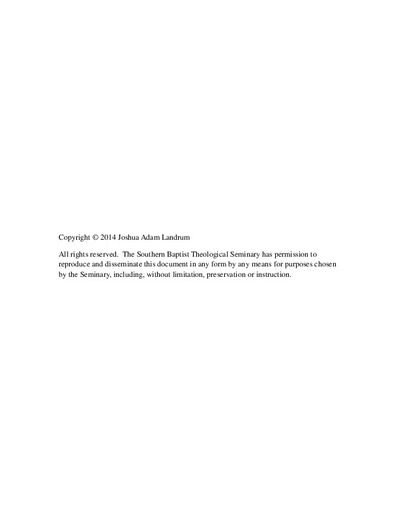Establishing an Evangelistic Children's Ministry at Knoxville Baptist Church, Williamstown, Kentucky
Subject
Church work with childrenAbstract
ABSTRACT
ESTABLISHING AN EVANGELISTIC CHILDREN'S MINISTRY
AT KNOXVILLE BAPTIST CHURCH,
WILLIAMSTOWN, KENTUCKY
Joshua Adam Landrum, D.Min.
The Southern Baptist Theological Seminary, 2014
Faculty Supervisor: Dr. Adam W. Greenway
The purpose of this project was to establish an evangelistic children's ministry at Knoxville Baptist Church, Williamstown, Kentucky. This project also provides a reproducible program to establish an evangelistic children's ministry.
Chapter 1 gives an overview of the entire project. This overview covers the project's goals and ministry context, including information concerning events leading up to the project's initialization. Moreover, this chapter gives the rationale for establishing an evangelistic children's ministry at Knoxville Baptist Church, Williamstown, Kentucky. Finally, this chapter serves as an outline for the rest of the project, including research methodology and statistical analysis of the research data.
Chapter 2 provides a biblical and theological basis for establishing an evangelistic children's ministry. The following passages are examined in detail and serve as the basis for the project: Acts 1:8, Matthew 28:18-20, Mark 10:13-16, and Matthew 18:1-6.
Chapter 3 entails the theoretical and sociological considerations for child evangelism and children's ministry. This chapter shows the importance of contextualizing the gospel because of children's cognitive abilities. Further this chapter looks into historical gospel contextualization and how some gospel presentations are better than others. Finally, this chapter provides seven areas children's ministries must focus upon to be able to contextualize children's ministry, which are: prayer, parents, preparation, purpose, participation, plasticity, and personalization.
Chapter 4 describes in detail the fifteen weeks of this project. This chapter breaks down each phase of this project and includes details about the curriculum building, training, practicum, and analysis.
Chapter 5 is an evaluation of the project. This chapter analyzes the short-term effectiveness of this project on the participants and the teacher. Furthermore, the final chapter includes the strengths and weaknesses of each phase, as well as suggestions on how to improve this project.

